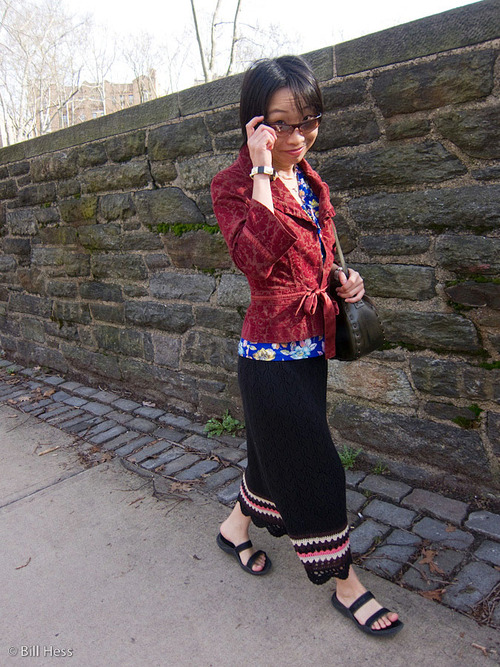
When Chie Sakakibara was growing up in Japan, she thought the indigenous people of the Americas were Caucasion. Hollywood movies were her primary source of education about Native Americans and those that she saw on film were usually portrayed by white people. She believed what she saw.
Chie is now Dr. Chie Sakakibara, with a PhD in Cultural Geography from the University of Oklahoma, where she first enrolled in 1998 as an undergraduate student in Native American Studies.
Readers who have been following my New York series will recall that, after inviting me to show my slides at the class she teaches at Columbia University, Chie had invited me to tour The Cloisters museum with her the following Saturday. The museum closes at 5:15 and so she suggested that I meet her at 3:00 PM, but first I got a late start to the day and then I underestimated how much time my little jaunt to Ground Zero and St. Paul's chapel would take. To make it worse, after I rode the subway from the bottom of Manhattan to the top, I got off the train at the wrong stop and had to hike three blocks to our meeting place. By then it was about 4:00 PM - maybe even a bit later.
Once we got together, we still had a good distance to walk to reach The Cloisters. We set off at a brisk pace, but the company was pleasant and the conversation good all the way.
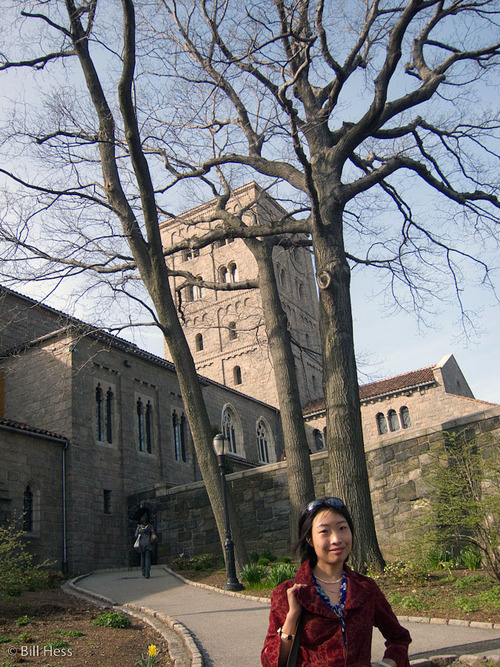
One day back in Japan, Chie went to a different kind of movie than those she had seen before - Dances With Wolves, starring Kevin Costner along with a cast of mostly American Indian actors, such as Grahamn Green and Rodney Grant.
"I was so surprised to see that they were not Caucasion, but they had dark eyes and black hair - like me," Chie remembers. She listened to their language and heard similarities to Japanese. She wondered how this could be, so she went to the library, where she read about the Bering Land Bridge and theories of how Asian people had migrated across into the Americas.
She also wrote a letter to Michael Blake, the author of the book, Dances With Wolves, who also authored the screen play for the movie. She told him that she wanted to learn more about Native Americans and asked how she might go about it. She waited for nearly three months, but heard nothing in response.
Here is Chie, after we hiked up a high hill overlooking the Hudson River and reached The Cloisters, which, in the early 20th Century, was reconstructed from the stones of five different monasteries originally built in medieval France.
It is a branch of the Metropolitan Museum of Art, "The Met", dedicated to artwork from medieval Europe and houses a permanent collection of over 6000 pieces of art dating back to 800 AD.
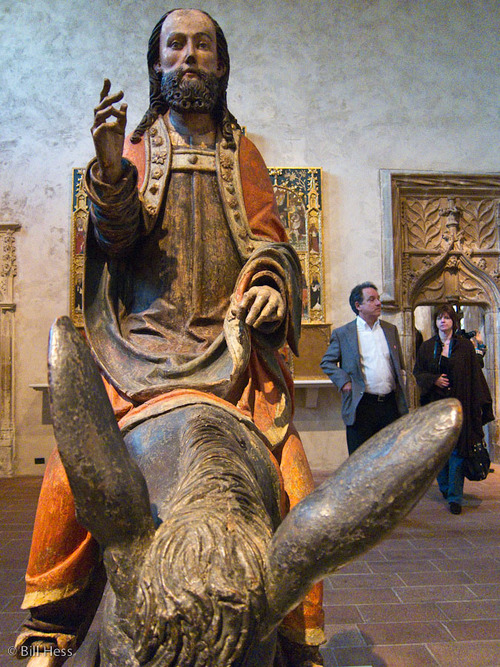
After three months passed, Chie was surprised when she received a letter from author Michael Blake. He suggested that if she really wanted to learn about Native Americans, she come to the United States and walk among them herself. The two then began to correspond regularly. Blake helped her arrange the funding to come to the US to study.
After she boarded the jet and flew away from Japan for the first time, Chie found herself feeling lonely and frightened. She thought that she was on a route that would take her over Hawaii, but in time, despite her fear of heights, she looked down and saw a magnificent, vast, land opening up beneath her. She saw a boat in the water and she also thought she saw a whale.
This was Alaska, the pilot said. She was entranched by the wild beauty of the place. She continued on to Norman, Oklahoma, a place surrounded by many American Indian Nations, where she enrolled in the University of Oklahoma. Yet, she knew that she must return to that land that she had flown over, that she must get to know it's indigenous people - most especially those who hunt the whale.
She still carries an Oklahoma driver's license (and she does not drive in New York City) and her boyfriend lives in Norman, so Oklahoma is still home to her in a way that New York is not.
I must also add that Barrow and the Arctic Slope of Alaska is also home to Chie in a way that New York is not.
In fact, based on my own relationship with Barrow and the Arctic Slope, and having observed Chie with some of the Iñupiat who have adopted her, I would say that Alaska's Far North is a most unique and special home to her, one that will never be duplicated anywhere else.
Except to visit, she does not intend to return to Japan. She is building her life in the United States.
The above, by the way, is a sculpture of Jesus, riding a donkey into Jerusalem and originated in 15th Century Germany. It sits on a cart, so that it could be wheeled into the local church on Palm Sunday celebrations.
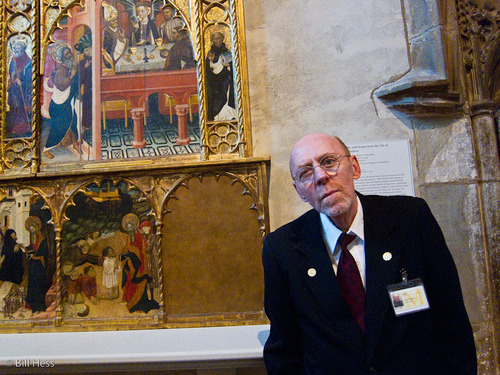
This is David Ferrando, a guard at the museum and an accomplished artist whose work has been exhibited at The Met. In his artist statement, Ferrando says:
"I am an artist employed by God. I am not working. God is dreaming through me. In the illusion of life I have many veils of consciousness..."
David took an interest in Chie and me, and spent some time chatting with us.
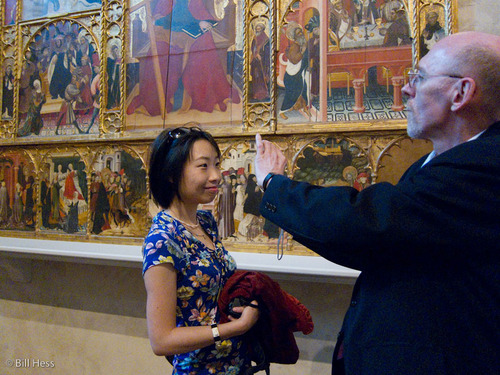
David also likes to make pictures. He photographed us both, one at a time, and very close up. He showed us the images on his LCD screen and although you cannot put a camera with a wide-angle lens that close to a face without dramatically enlarging the nose, the images were strong; they had the look of being made by an artist.
The image of Chie was more pleasant to look at than the one of me, of course.
If there was only one person that we would meet and talk to in this medievel museum - and indeed there was only one - I would have wanted it to be no one but David. He was just the right one.
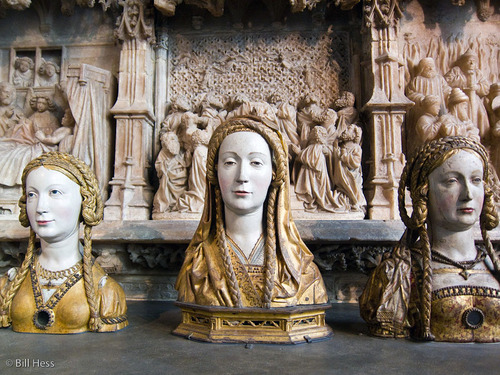
These three alabaster ladies are the work of sculptor Franci Gomar and were created between 1456-58.
I believe the one in the middle is the likeness of the Saint Ursula and the other her companions - although I am a bit confused on this point. They might all three be companions to St. Ursula. Ursula was a teacher in England who is said to have loved her students greatly. Invaders came into her area and threatened to kill all Christians, so Ursula took her students and the other teachers who worked with her and led them to France.
There, they were captured by the Huns, who wanted to make slaves of Ursula's students, mostly little boys and girls. Ursula refused to allow that, so the Huns told her that they would let all go free, if only they would renounce Christ and their Catholic faith - otherwise, they would kill them.
All refused. So the Huns notched their arrows, drew back their bows and murdered each and every one. All these martyrs, the Catholic faith says, went straight to Heaven.
As beautiful as these alabaster sculptures are, when I looked at this image that I took of them on my LCD, it seemed to me that something was missing...
What...?
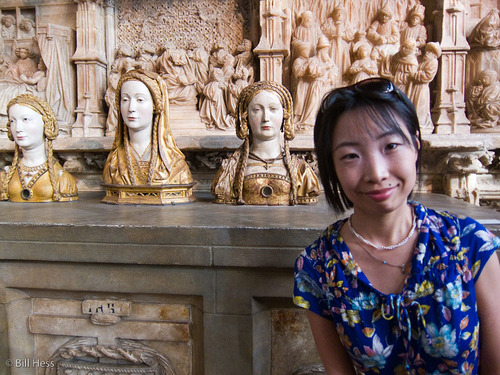
Why, it was Chie who was missing! Here she is!
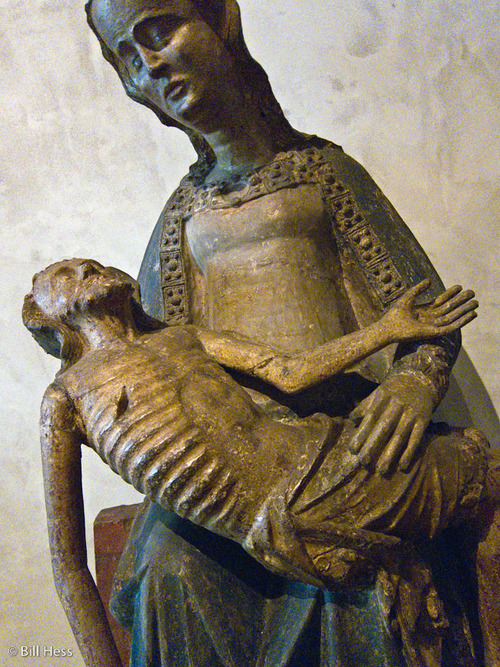
This is a Pietà (Vesperbild), Mary holding her slain son, Jesus, carved from wood in Germany sometime between 1375 and 1400.
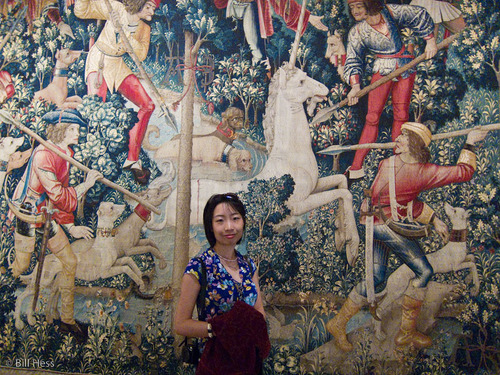
There are a series of tapestries about a unicorn hanging in The Cloisters, believed to have been designed in France and made in Brussels. The series begins in beauty and then follows the unicorn as people persecute and kill it. In the final tapestry, the unicorn is alive. This story of the unicorn is thought to be symbolic of the life, persecution, crucifixion and resurrection of Christ.
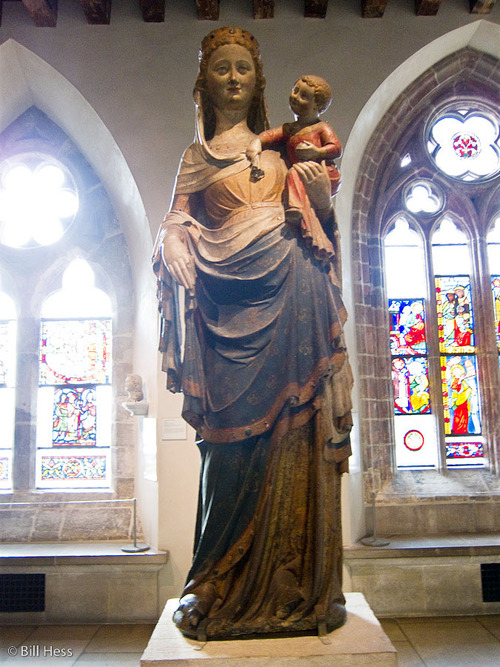
When we reached this statue of Mary and a rather mature-looking baby Jesus, our time before closure was running very short. Everything that I know about this statute is contained within this photograph.
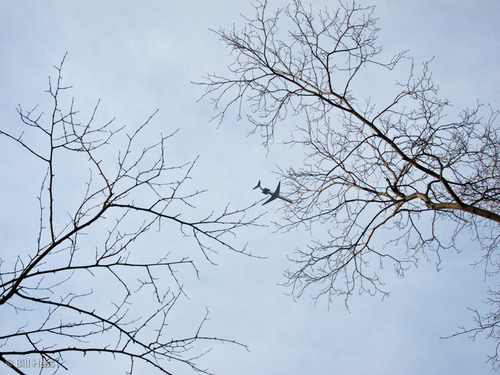
Then, before Chie and I were ready to leave Medieval Europe and venture back out into the upper-most reaches of Manhattan, where Spanish is the most common language heard on the street, museum staff announced that we had to vacate the building, as they were about to lock the doors.
As we headed to the main exit, we saw David standing somberly ahead of us as visitors filed past. When he saw us approaching, he smiled broadly, gave us a warm goodbye and told us that he hoped he would see us again someday soon.
Chie asked if I would like to see the place where the Dutch are said to have purchased Manhattan from the Reckgawanang Indians. Yes, I answered. She warned that it was a long walk. That's okay, I said. I walk all the time.
So off we walked.
I saw many potential pictures along the way, but I did not take any of them. As I noted in my Central Park essay, the battery in my pocket camera had begun to fail. Now it had grown even weaker and the low charge light was flashing. I feared that if I took pictures along the way, it might be dead by the time we reached the site and I would get no pictures of the monument.
Yet, I cannot let an airplane pass overhead without taking a photo of it.
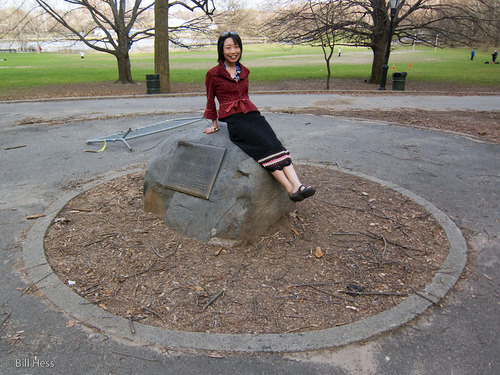
Here is Chie, sitting on the rock that legend claims marks the very spot where the Dutch purchased Manhattan Island for 60 guilders - about $1000 in today's currency. When I was a young schoolboy, we were taught this purchase was done in beads and trinkets that totalled $24.
This information was passed to us in a sort of snickering way that said, "look how clever those white Dutch were and how gullible those dark Indians."
No deed can be found of the actual transaction and whether it was beads or other items of trade is not really known. One thing I am quite certain of - whatever transpired here on that day in 1624, the Reckgawanang surely interpeted it much different than did the Dutch. I do not at all believe that they thought they had just given away their bounteous homeland.
I am also certain that the Dutch survived their early days on Manhattan only due to the good graces of the Reckgawanang.
Who can now find a Reckgawanang on Manhattan?
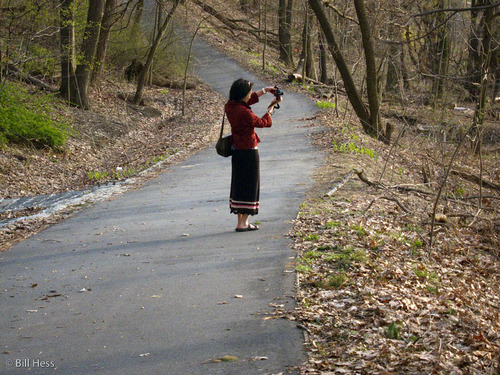
Chie then took me on a walk through Inwood Park, which encompasses the monument. By urban standards, it is a gigantic park. While tame by Alaska standards, it is much more wild than Central Park - indeed, more wild than anything I had ever expected to see in Manhattan.
Chie is like me in that she wants to photograph everything that she sees. She flatters me, by telling me that it is my work that inspired her to take up photography. She currently shoots a Canon Powershot G10, which she bought at my recommendation - a G10 being the pocket camera that I used all the time before Melanie and Charlie gave me this even tinier s90 for Christmas.
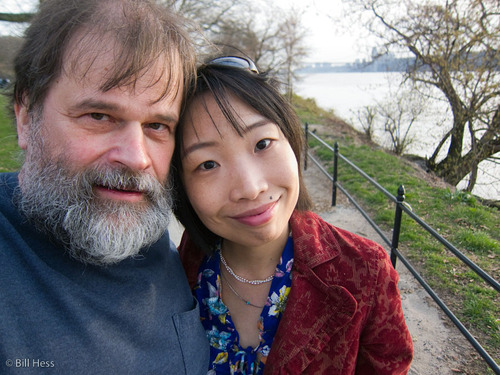
She asked if I would mind if she took a picture of us together, head-to-head. After she took it, she showed it to me. I liked it, and so decided to take a similar one myself, and this is it. Chie told me that the Barrow families who have taken her in have looked at her pictures and have told her that she do should do as I have done and make a serious effort to photograph life on the Arctic Slope.
She has protested that this is beyond her talent, but I have looked at her pictures and I disagree. She has talent, a natural eye, and an ability to connect with people that goes beyond that possessed by shy, reclusive, withdrawn, me. She could well do it, far beyond the last day that I pick up a camera. Where it was a long, tough, struggle for me to gain the acceptance that I now enjoy, Chie has been loved in the Arctic from the day she first stepped off the plane into Barrow.
On that day, as she crossed a street, two Elder women stopped her and asked her a question in Iñupiaq. She did not understand. "What?" she responded.
"Who are you? Who is your mother? Who is your father?" they asked.
When she told them that she not from Barrow, but from Japan, they laughed.
"Oh! We thought you were one of us!"
And so she has become.
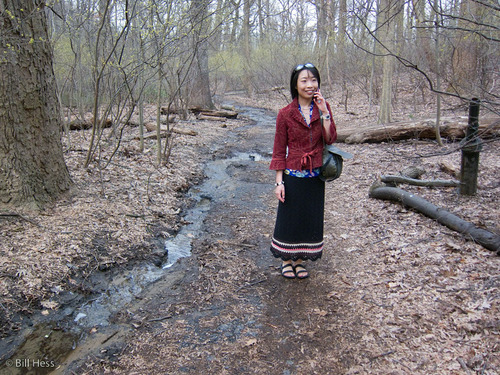
Not long after that, the Akootchook Crew, captained by Roy Nageak and wife Flossie, landed a bowhead. Roy's sister-in-law, Mae Ahgeak, invited her to come by the house for the first feed. She did. She helped with the preparations and she happily joined in the dining.
Roy and Flossie loved her right away and brought her into their family. Roy gave her an Iñupiaq name: Kuninga.
Not long after that, she met the late Barrow Elder, Dr. Kenneth Toovak. He asked her name and she told him, "Kuninga." He smiled big, and gave her a little kiss.
Later, she told a couple of other men her Iñupiaq name. They didn't kiss her, but they did break out with big smiles. Her new name spread quickly throughout the town, everywhere she went, people looked at her and smiled.
So she asked, and found out that her adopted dad had given her the name, "Kiss Me."
She was also given a second name, Siqiniq. This means, "Sunshine."
That is the name she is now most commonly called.
As to the picture above, there are some caves in the park that were frequented by the Indians of old. Chie hoped to find and show a couple of these caves to me. Just before I arrived in New York, a huge rainstorm hit the city and had downed many trees in this park.
Even now, water still flowed down the trail. Chie did not find the caves, but, after having made several tries, she did connect with her colleague, Aaron Fox, on her cellphone. She arranged for he and I to meet for breakfast the next morning, just before I was scheduled to depart New York.
Immediately after I took this image, my battery died. Immediately after that, we happened upon a very enchanting and mysterious scene. We found three people, all Hispanic, gathered in prayer-like positions around a large, white, crystal bowl. A man continually rubbed the edge of the crystal with a round wooden stick in a rotating motion, creating an ethereal hum. I did not want to disrupt them, but the man said it was okay, that we could come through, and he showed us the crystal and demonstrated how it worked.
Sometimes, if I hold a camera battery in my hand inside my pocket after it dies and I warm it up, I can get another picture out of it. So I gripped the battery and pushed it deep into my pocket, hoping not to miss the next picture.
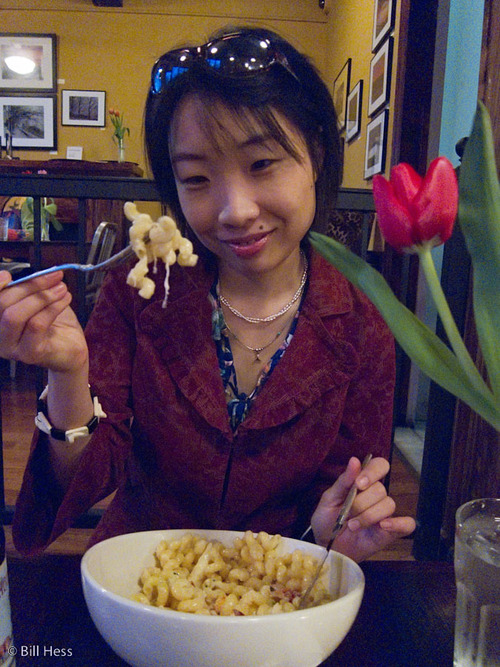
Chie then took me to dinner at the Indian Road Cafe, where they had created a special menu for Easter weekend. Among the specials was a bunny rabbit soup, with whole carrots. Easter Bunny stew. I ordered it. It was delicious. Chie ordered a macaroni dish.
I put my battery back in my camera, and managed to get a couple more frames out of it, including this one. Then it died again.
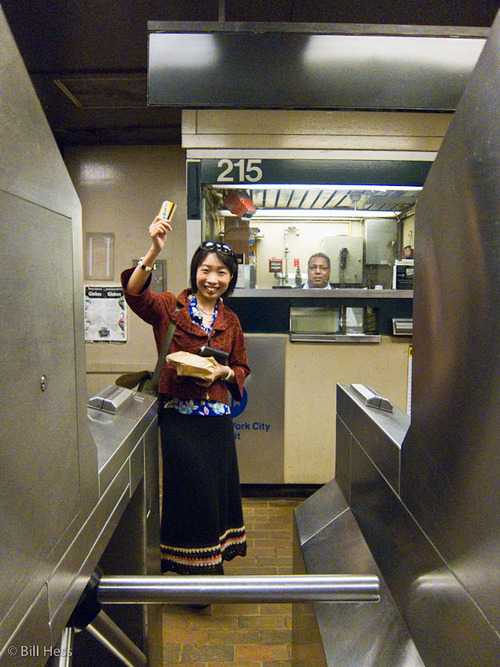
After we ate, I again gripped my battery in my hand and held it deep in my pocket as Chie walked me to the Subway station. When we got there, I pulled out my Metro card, but it was low and needed to be recharged. Chie insisted on using her card to get me into the station.
After I passed through the turnstile, I pulled the hand-heated battery out of my pocket and slipped it back into my camera. It had gained enough recharge for just one more shot. This is it.
Our final goodbye.
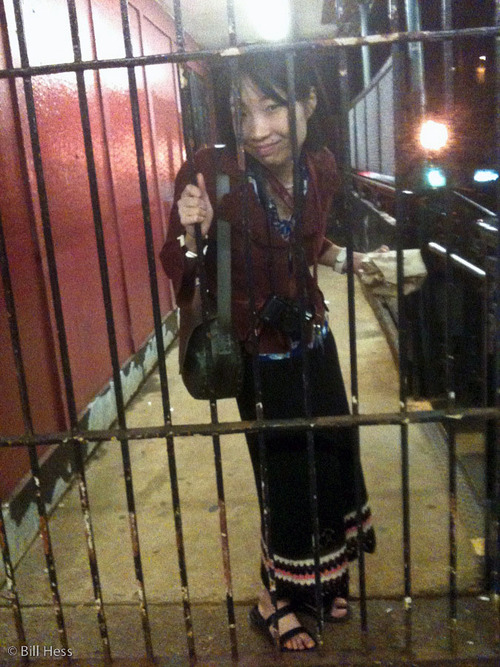
Or so I thought.
Just before my train arrived, I heard a voice, turned around and there was Chie, who had come to the fence to say one last goodbye. My camera battery was dead - but then I remembered that I can take pictures with my iPhone, so I did.
Now I had to get on the train and go. It is always sad to see a friend disappear behind you, not knowing when you will see her again, but one way or another, that is how it always happens.
My next entry will cover my breakfast the following morning with Aaron Fox. I will relate a bit about how he and Chie teamed up to restore something very precious to the Iñupiat, something that might have been lost forever to them, had it not been for the good works and big hearts of Chie Sakakibara and Aaron Fox.
 Thursday, April 15, 2010 at 11:11PM
Thursday, April 15, 2010 at 11:11PM 



















































